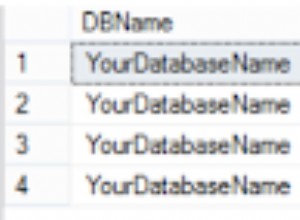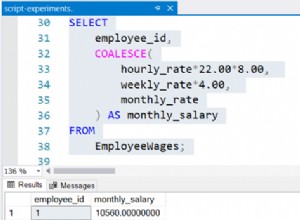Als ich anfing, diese Frage zu beantworten, dachte ich, es wäre schnell und einfach, weil ich etwas sehr Ähnliches schon einmal in SQL Server gemacht hatte, aber das Konzept in der Übersetzung zu beweisen, keimte in dieser vollständigen Lösung auf.
Eine Einschränkung, die aus Ihrer Frage nicht klar hervorgeht, ist, ob Sie eine Bedingung für die Deklaration der primären ID gegenüber der Alias-ID haben. Diese Lösung ermöglicht beispielsweise 1 den Alias 4 sowie 4 den Alias 1, was mit den bereitgestellten Daten in Ihrer vereinfachten Beispielfrage übereinstimmt.
Um die Daten für dieses Beispiel einzurichten, habe ich diese Struktur verwendet:
CREATE TABLE notnormal_customers (
id INT NOT NULL PRIMARY KEY,
aliases VARCHAR(10)
);
INSERT INTO notnormal_customers (id,aliases)
VALUES
(1,'|4|58|76'),
(2,''),
(3,''),
(4,'|1|58|76'),
(58,'|1|4|76'),
(76,'|1|4|58');
Um die Eins-zu-Viele-Beziehung für Ein-Kunde-zu-Viele-Aliasnamen darzustellen, habe ich zunächst diese Tabelle erstellt:
CREATE TABLE customer_aliases (
primary_id INT NOT NULL,
alias_id INT NOT NULL,
FOREIGN KEY (primary_id) REFERENCES notnormal_customers(id),
FOREIGN KEY (alias_id) REFERENCES notnormal_customers(id),
/* clustered primary key prevents duplicates */
PRIMARY KEY (primary_id,alias_id)
)
Am wichtigsten ist, dass wir einen benutzerdefinierten SPLIT_STR Funktion
:
CREATE FUNCTION SPLIT_STR(
x VARCHAR(255),
delim VARCHAR(12),
pos INT
)
RETURNS VARCHAR(255)
RETURN REPLACE(SUBSTRING(SUBSTRING_INDEX(x, delim, pos),
LENGTH(SUBSTRING_INDEX(x, delim, pos -1)) + 1),
delim, '');
Dann erstellen wir eine gespeicherte Prozedur, um die ganze Arbeit zu erledigen. Code wird mit Kommentaren zu Quellenverweisen kommentiert.
DELIMITER $$
CREATE PROCEDURE normalize_customers()
BEGIN
DECLARE cust_id INT DEFAULT 0;
DECLARE al_id INT UNSIGNED DEFAULT 0;
DECLARE alias_str VARCHAR(10) DEFAULT '';
/* set the value of the string delimiter */
DECLARE string_delim CHAR(1) DEFAULT '|';
DECLARE count_aliases INT DEFAULT 0;
DECLARE i INT DEFAULT 1;
/*
use cursor to iterate through all customer records
http://burnignorance.com/mysql-tips/how-to-loop-through-a-result-set-in-mysql-strored-procedure/
*/
DECLARE done INT DEFAULT 0;
DECLARE cur CURSOR FOR
SELECT `id`, `aliases`
FROM `notnormal_customers`;
DECLARE CONTINUE HANDLER FOR NOT FOUND SET done = 1;
OPEN cur;
read_loop: LOOP
/*
Fetch one record from CURSOR and set to customer id and alias string.
If not found then `done` will be set to 1 by continue handler.
*/
FETCH cur INTO cust_id, alias_str;
IF done THEN
/* If done set to 1 then exit the loop, else continue. */
LEAVE read_loop;
END IF;
/* skip to next record if no aliases */
IF alias_str = '' THEN
ITERATE read_loop;
END IF;
/*
get number of aliases
https://pisceansheart.wordpress.com/2008/04/15/count-occurrence-of-character-in-a-string-using-mysql/
*/
SET count_aliases = LENGTH(alias_str) - LENGTH(REPLACE(alias_str, string_delim, ''));
/* strip off the first pipe to make it compatible with our SPLIT_STR function */
SET alias_str = SUBSTR(alias_str, 2);
/*
iterate and get each alias from custom split string function
https://stackoverflow.com/questions/18304857/split-delimited-string-value-into-rows
*/
WHILE i <= count_aliases DO
/* get the next alias id */
SET al_id = CAST(SPLIT_STR(alias_str, string_delim, i) AS UNSIGNED);
/* REPLACE existing values instead of insert to prevent errors on primary key */
REPLACE INTO customer_aliases (primary_id,alias_id) VALUES (cust_id,al_id);
SET i = i+1;
END WHILE;
SET i = 1;
END LOOP;
CLOSE cur;
END$$
DELIMITER ;
Schließlich können Sie es einfach ausführen, indem Sie Folgendes aufrufen:
CALL normalize_customers();
Dann können Sie die Daten in der Konsole überprüfen:
mysql> select * from customer_aliases;
+------------+----------+
| primary_id | alias_id |
+------------+----------+
| 4 | 1 |
| 58 | 1 |
| 76 | 1 |
| 1 | 4 |
| 58 | 4 |
| 76 | 4 |
| 1 | 58 |
| 4 | 58 |
| 76 | 58 |
| 1 | 76 |
| 4 | 76 |
| 58 | 76 |
+------------+----------+
12 rows in set (0.00 sec)




